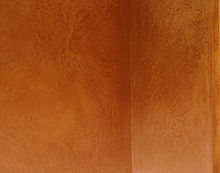Tadelakt: Difference between revisions
No edit summary |
Undid revision 336180732 by 94.169.112.115 (talk) |
||
| Line 27: | Line 27: | ||
* [http://www.youtube.com/watch?v=Wvf2UGMnjuE&feature=related Educational video showing Tadelakt preparation] |
* [http://www.youtube.com/watch?v=Wvf2UGMnjuE&feature=related Educational video showing Tadelakt preparation] |
||
* [http://www.youtube.com/watch?v=Zw3GrgskIsE Tadelakt application in a modern home] |
* [http://www.youtube.com/watch?v=Zw3GrgskIsE Tadelakt application in a modern home] |
||
* [http://www.youtube.com/watch?v=_PulKf6qFqo&feature=channel Tadelakt application on columns] |
|||
* [http://www.authentic-plaster-fx.net/wordpress/?p=224 Blog showing Tadelakt used for exterior cladding] |
|||
==See also== |
==See also== |
||
Revision as of 05:38, 28 January 2010
Tadelakt or Tadellakt is a bright, nearly waterproof lime plaster which can be used on the inside of buildings and on the outside. It is the traditional coating of the palaces, hammams and bathrooms of the riads in Morocco. Its traditional application includes being polished with a river stone and treated with a soft soap to acquire its final appearance and water resistance. Tadelakt has a luxurious, soft aspect with undulations due to the work of the artisans who finish it; in certain installations, it is suitable for making bathtubs, showers, and washbasins and confers great decorative capacities. Traditionally, tadelakt is produced with the lime of the area of Marrakech.

The restoration of the riads of Morocco has focussed attention on this ancient technique.
Expanded Definition
Tadelakt more generally refers to any lime plaster applied according to the principles and techniques of Moroccan tadelakt, but using the lime bodies available in places other than Marrakech.
Defining Materials and Techniques
The basic characteristics of a tadelakt plaster are these: 1) It is a lime plaster. It does not include Portland cement. 2) It may include fine marble or limestone sand, but not other aggregates. 3) It has been compressed when plastic, eliminating all voids. 4) It has been mechanically polished, using stones or abrasives that are harder than the plaster finish, to provide a smooth, sometimes shiny, finish. 5) It has been treated with a natural soap (often "black" or olive oil soap) to speed carbonation of the surface and render the surface more water-resistant.
See also
External links
- What is the price of Tadelakt?
- Some examples of tadelakt
- Educational video showing Tadelakt preparation
- Tadelakt application in a modern home
- Tadelakt application on columns
- Blog showing Tadelakt used for exterior cladding
See also
